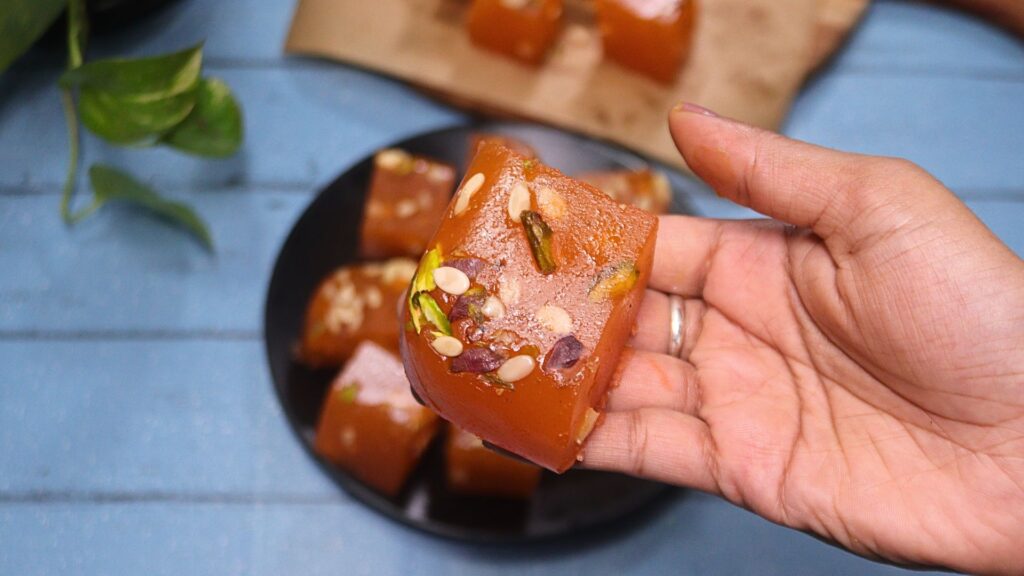



Bombay Karachi Halwa, also known as cornflour halwa, has a rich history intertwined with the cultural tapestry of the Indian subcontinent. Its origins trace back to the bustling trade routes and vibrant markets of Mumbai (formerly Bombay) and Karachi, two major port cities with a shared history before the partition of India and Pakistan in 1947.
Bombay Karachi Halwa is a classic Indian confection that has captured hearts and taste buds for generations. This delightful sweet treat is renowned for its unique chewy texture and vibrant colors. Originating from the bustling streets of Mumbai and Karachi, this halwa is a staple in festive celebrations and special occasions.
Made with a simple yet exquisite blend of corn flour, sugar, ghee, and water, Bombay Karachi Halwa is elevated with the fragrant touch of cardamom and the crunch of roasted nuts. Each bite offers a perfect harmony of flavors and textures, making it an irresistible indulgence for all ages.
Whether celebrating a festival, marking a special milestone, or simply craving something sweet, Bombay Karachi Halwa promises to bring joy and a touch of tradition to your table.

Indian cuisine is renowned for its rich and diverse array of sweets, and halwa holds a special place among these cherished desserts. Each type of halwa offers a unique taste experience, reflecting the regional flavors and ingredients that make Indian sweets so beloved. Here's a journey through some of the most popular types of Indian halwa:
Suji halwa, or sheera, is a simple yet delectable dessert made from semolina, ghee, sugar, and water or milk. Often flavored with cardamom and garnished with nuts, it is a staple in Indian households, especially during festivals and religious ceremonies.
Made from roasted chickpea flour (besan), this halwa has a distinctive nutty flavor and a soft, melt-in-the-mouth texture. It is cooked with ghee and sweetened with sugar, then enhanced with cardamom and garnished with nuts, making it a popular choice during winter.
A beloved winter delicacy, gajar ka halwa is made from grated carrots slowly cooked in milk and ghee, then sweetened with sugar. This halwa is often garnished with a generous amount of nuts and sometimes a hint of saffron, making it a rich and flavorful treat.
This rich and aromatic halwa is made from split yellow mung beans (moong dal), ghee, sugar, and milk. It requires careful roasting to achieve its unique taste and is often served during special occasions and festivals.
Badam halwa is a luxurious dessert made with ground almonds, ghee, sugar, and milk. It has a smooth, velvety texture and is often flavored with cardamom and saffron, making it a favorite during festive seasons.
A traditional North Indian dessert, atte ka halwa is made from whole wheat flour, ghee, and sugar. It is often prepared as a prasad (offering) during religious ceremonies and is enjoyed for its warm, comforting flavor.
Known for its chewy texture and vibrant colors, Bombay Karachi halwa is made from corn flour, ghee, and sugar. This halwa is often flavored with cardamom and studded with nuts, making it a festive favorite.
Chana dal halwa is a rich and flavorful dessert made from split Bengal gram, ghee, and sugar. It is often flavored with cardamom and garnished with nuts, providing a hearty and satisfying sweet treat.
Each type of Indian halwa offers a distinct taste experience, reflecting the diverse culinary traditions and regional ingredients of India. Whether you prefer the nutty richness of besan halwa, the vibrant sweetness of gajar ka halwa, or the luxurious texture of badam halwa, there's a halwa to satisfy every sweet tooth. Explore these delightful varieties and enjoy the rich, comforting flavors that have made halwa a beloved dessert for generations.
